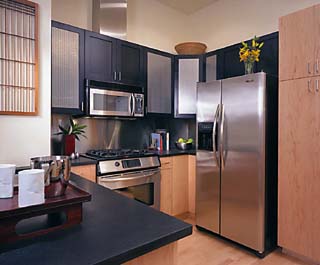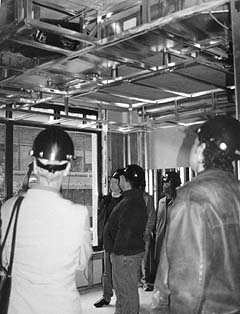
DJC.COM
September 26, 2002
Joe Average inks blueprints for downtown living
Marin Development

Washburn |
We know a downtown location sells homes, but beyond that, what matters? Developers are increasingly involving consumers in all facets of the design and development process.
Developers (and marketers) are realizing consumers hold the answers that will help prioritize construction questions and sell condominiums. Their impact affects a building’s footprint, individual floor plans, features and interior design.
Involving buyers in the decision-making process offers the true value of ownership. There’s a certain mindset in shaping a home versus just buying a home. It goes beyond the typical condominium sales presentation, which seems to say, “Here’s what we have, take it or leave it.” It requires considerable more time, money and logistics, but in a tougher real estate market, consumers are likely to demand this type of involvement.

Photo courtesy of Marin Development Input from potential buyers and brokers resulted in stainless steel appliances, side-by-side refrigerators and stainless steel sinks in Bellora kitchens. |
Consumers’ perspective
Consumers are smart. They know what they want. And, what they don’t want. If you want to sell to them, you better talk to them. Many downtown condominiums are involving potential buyers in the development process. Consumers have the insight to know whether master baths warrant separate showers and soaking tubs, or if the money is better spent developing more storage space. These details are important to sell urban homes.
Urban design demands fluctuate
Urban developments sell to a typically younger demographic — people interested in current trends. They’re a little less conservative than suburban homebuyers, and certainly more savvy. What they want one year, or even one month from now, may be different from what they want the next year. Some cities have very progressive designs and alternative floor plans, but only the consumers and agents in touch with consumers can tell you whether Seattle’s ready for that. It is not information you can easily get from second-hand research.
In recent years, I’ve become a strong believer that regular communication with both buyers and real estate agents sells best today. With a slower, tougher market, a more flexible development process will be essential.
The collaborative process
A lot of developers, and agents for that matter, give lip service to potential buyers’ suggestions. Some even negotiate for small changes. I propose the time is ripe for building professionals and potential clients to engage in an ongoing dialogue, a two-way communication that will shape buildings together.
My confidence in the collaborative process was a driving force in the current construction of Bellora, a new 89-home condominium development in Belltown. Early in the design process, we involved people familiar with the condominium lifestyle — existing owners, prospective owners and sales agents.
In a series of focus groups, we presented initial floor plans and probed about priorities within a given price range. In addition, throughout the construction stages, we’ve given hardhat tours of the building to homeowners to show progress and solicit additional input. Since our pre-sales efforts have far exceeded original expectations, we’re convinced that the time, effort and money spent in this collaborative process really do generate sales and make homes more desirable.
The ongoing process
In the beginning, I didn’t fully contemplate the extent of potential changes or the ways in which the development could be shaped by homeowners and real estate agents. Some of the early feedback on Bellora resulted in floor plan changes — larger and more elegant master baths and bigger kitchens, for example. When a designer presented an unusual idea for sliding panel partitions between the master bedroom and living space, we looked to our constituents for approval. They embraced the idea, and it has since received tremendous feedback. Later, our buyers gave their reactions to smaller details such as which appliance brands they preferred — Kitchen Aid versus GE refrigerators.
Beyond the initial decisions, there remains a lot of room — and need — for input. As one of the smaller condominium buildings in town, we originally did not plan for a fitness facility. However, after the concrete was poured up to the eighth and ninth floors, we re-engineered building space to take advantage of some excess garage area.

Buyers of Belltown’s Bellora condominiums are invited to periodic hardhat tours before the building is complete. |
When construction of Bellora was about one-third complete, we heard a request for a computer niche and another for an additional half bath. Aside from the cost and logistics of changing floorplans in the midst of construction, why not? So, from Bellora’s fourth floor up, some homes have a computer niche and/or half baths replacing the space where extra storage space might have been. The one existing owner of the floor plan in which we added the half bath was given the option to change or leave the original plan.
At our on-going “buyer breakfasts,” new homeowners have the opportunity to voice their opinions about the building prior to completion. At one breakfast they were given the option of a side-by-side refrigerator that stuck out slightly in the room, or one that remained flush. To our surprise, the one that did not sit flush was more popular, so we provided side-by-side refrigerators for the majority of the homes. The freezer-down model remained available (at no additional cost) to the few buyers that requested it.
At another breakfast, buyers chose by majority vote what color mini-blinds to have in their homes.
The challenges
Incorporating input and perspectives from outside the building industry presents several challenges — money, time and coordination among them. Like most collaboration, the result is an ever-changing process. However, clients seem quick to understand that there needs to be a consensus and that every suggestion may not get incorporated. The benefits of this process, however, seem to far outweigh the challenges.
The benefits
| Tweaking Bellora |
Bellora, an 89-home development in Seattle’s Belltown, has been, and continues to be, influenced by potential buyers, homeowners and real estate agents. The following are a few of the changes to the original building plans that resulted from the collaborative input.
|
Through this process, potential buyers and brokers gave us valuable information about their preferences. We educated them about what is, and is not, possible in this type of construction. We can offer clients a better understanding of why certain construction has long-term benefits, and show why some choices are more expensive.
Sabine Lucier, an associate broker in downtown Seattle, feels the collaborative process is a helpful sales and educational tool for both her clients and herself. A participant in the preliminary Bellora focus groups, Lucier appreciated the opportunity to convey her clients’ wishes, like incorporating fireplaces and high-quality appliances into the homes. Lucier also feels the on-going communication process is important to buyers, who may buy sight unseen and need to wait four or five months before seeing their new home.
Beyond broker and buyer goodwill, the two-way communication gives developers valuable insight as to what can increase demand. The target market speaks directly to the developer and builder, resulting in a development more closely aligned with what consumers need and want. Chances are, if the majority of current buyers prefer side-by-side refrigerators and silver mini-blinds, the majority of the “yet to be” buyers will as well.
Future success relies on input
Though involving the consumer may have been progressive at one time, I believe consumer and agent input will soon be vital to successful developments. We’ll see more consumers impacting blueprints and more agents shaping floor plans. Collaboratively built homes are the ones that will succeed in a tough urban market.
Steve Washburn is a partner in Marin Development Corp. LLC, developer of Bellora condominiums, an 89-home development currently under construction in Belltown. He has been intimately involved in all facets of construction, having worked in the industry since the age of 18.
Other Stories:
- Bellevue faces its next stage of evolution
- 10 steps to safer city streets
- All aboard for Kent’s rebirth
- Renton rebounds with infill projects
- UrbanSim: Shaping metropolitan futures
- Giving development the old college try
- The urban redevelopment toolbox
- SoDo rezone pits industry against developers
- Lower Queen Anne goes Uptown
- Marketing urban homes in turbulent times
- Understanding history improves future of cities
- Building design — post 9/11
- Monorail elevates transit to a new low
- Condemnation: Whose property is it?
- Building infrastructure for urban vitality
- Urbanization demands better quality housing
- Tax-exempt bonds pump up nonprofit projects
Copyright ©2009 Seattle Daily Journal and DJC.COM.
Comments? Questions? Contact us.